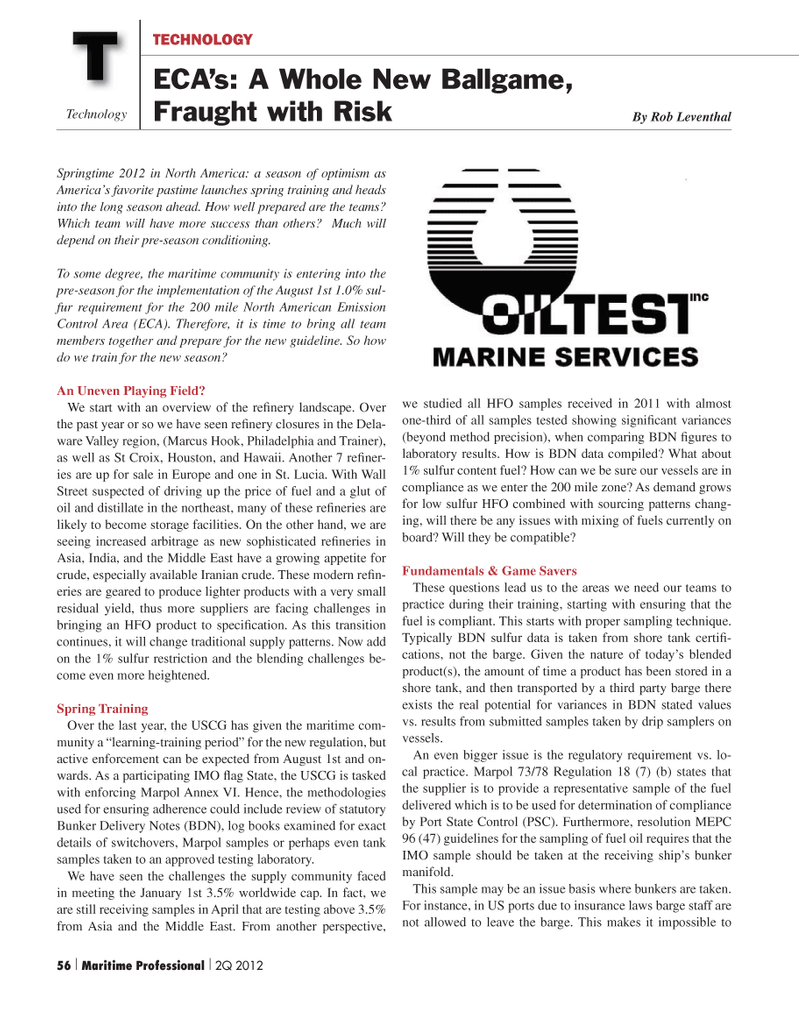
Page 56: of Maritime Logistics Professional Magazine (Q2 2012)
Maritime Risk
Read this page in Pdf, Flash or Html5 edition of Q2 2012 Maritime Logistics Professional Magazine
Springtime 2012 in North America: a season of optimism as
America’s favorite pastime launches spring training and heads into the long season ahead. How well prepared are the teams?
Which team will have more success than others? Much will depend on their pre-season conditioning.
To some degree, the maritime community is entering into the pre-season for the implementation of the August 1st 1.0% sul- fur requirement for the 200 mile North American Emission
Control Area (ECA). Therefore, it is time to bring all team members together and prepare for the new guideline. So how do we train for the new season?
An Uneven Playing Field?
We start with an overview of the refi nery landscape. Over the past year or so we have seen refi nery closures in the Dela- ware Valley region, (Marcus Hook, Philadelphia and Trainer), as well as St Croix, Houston, and Hawaii. Another 7 refi ner- ies are up for sale in Europe and one in St. Lucia. With Wall
Street suspected of driving up the price of fuel and a glut of oil and distillate in the northeast, many of these refi neries are likely to become storage facilities. On the other hand, we are seeing increased arbitrage as new sophisticated refi neries in
Asia, India, and the Middle East have a growing appetite for crude, especially available Iranian crude. These modern refi n- eries are geared to produce lighter products with a very small residual yield, thus more suppliers are facing challenges in bringing an HFO product to specifi cation. As this transition continues, it will change traditional supply patterns. Now add on the 1% sulfur restriction and the blending challenges be- come even more heightened.
Spring Training
Over the last year, the USCG has given the maritime com- munity a “learning-training period” for the new regulation, but active enforcement can be expected from August 1st and on- wards. As a participating IMO fl ag State, the USCG is tasked with enforcing Marpol Annex VI. Hence, the methodologies used for ensuring adherence could include review of statutory
Bunker Delivery Notes (BDN), log books examined for exact details of switchovers, Marpol samples or perhaps even tank samples taken to an approved testing laboratory.
We have seen the challenges the supply community faced in meeting the January 1st 3.5% worldwide cap. In fact, we are still receiving samples in April that are testing above 3.5% from Asia and the Middle East. From another perspective, we studied all HFO samples received in 2011 with almost one-third of all samples tested showing signifi cant variances (beyond method precision), when comparing BDN fi gures to laboratory results. How is BDN data compiled? What about 1% sulfur content fuel? How can we be sure our vessels are in compliance as we enter the 200 mile zone? As demand grows for low sulfur HFO combined with sourcing patterns chang- ing, will there be any issues with mixing of fuels currently on board? Will they be compatible?
Fundamentals & Game Savers
These questions lead us to the areas we need our teams to practice during their training, starting with ensuring that the fuel is compliant. This starts with proper sampling technique.
Typically BDN sulfur data is taken from shore tank certifi - cations, not the barge. Given the nature of today’s blended product(s), the amount of time a product has been stored in a shore tank, and then transported by a third party barge there exists the real potential for variances in BDN stated values vs. results from submitted samples taken by drip samplers on vessels.
An even bigger issue is the regulatory requirement vs. lo- cal practice. Marpol 73/78 Regulation 18 (7) (b) states that the supplier is to provide a representative sample of the fuel delivered which is to be used for determination of compliance by Port State Control (PSC). Furthermore, resolution MEPC 96 (47) guidelines for the sampling of fuel oil requires that the
IMO sample should be taken at the receiving ship’s bunker manifold.
This sample may be an issue basis where bunkers are taken.
For instance, in US ports due to insurance laws barge staff are not allowed to leave the barge. This makes it impossible to
Technology
TECHNOLOGY
ECA’s: A Whole New Ballgame,
Fraught with Risk
T
By Rob Leventhal 56 | Maritime Professional | 2Q 2012
MP #2 50-64 NEW STYLES.indd 56 5/4/2012 6:39:57 PM

 55
55

 57
57
